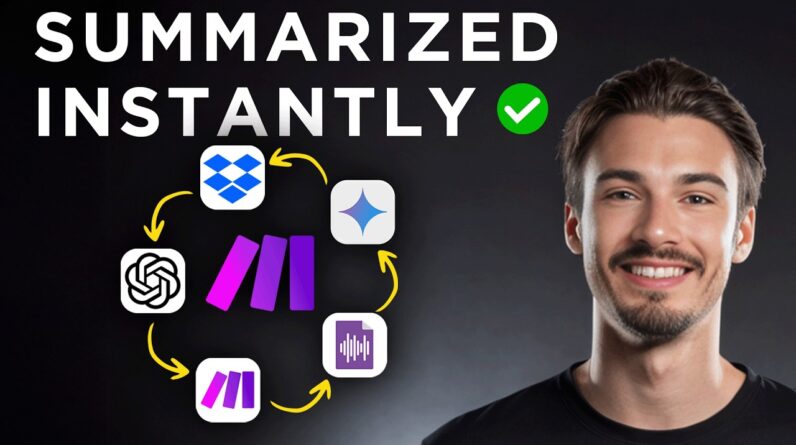
Creating personalized audio summaries in your own voice can revolutionize how you consolidate information from meetings, podcasts, and other content. This article will guide you through the process of setting up an automated workflow using tools like Make, ElevenLabs, and GPT-4o. You’ll explore the necessary components, learn how to integrate them effectively, and discover practical applications that enhance your productivity and maintain authenticity in your communications.
By the end, you’ll have a clear understanding of how to create custom audio files that sound just like you, saving time and effort while ensuring you stay connected. This friendly tutorial is designed for everyone, whether you’re a beginner or more experienced with automation tools. Get ready to transform your approach to summarizing content!

Table of Contents
Understanding Custom Audio Summaries
Definition and Importance
Custom audio summaries are recordings that encapsulate key information, discussions, or insights, tailored to reflect your voice and style. These summaries are particularly significant in today’s fast-paced world, where time is precious and information overload is common. Instead of sifting through lengthy texts or meeting notes, you can simply listen to a concise summary that sounds just like you. This not only saves time but also provides a personal touch, enhancing the listening experience and making it easier to retain information.
Applications in Various Fields
Custom audio summaries have diverse applications across many fields. In the corporate world, they are used for summarizing meetings, ensuring that those who couldn’t attend are kept in the loop. In education, teachers can summarize lectures or important discussions for students, offering an engaging alternative to written notes. Additionally, content creators can produce audio recaps of their podcasts or videos, allowing their audience to catch up on key points in a relatable voice. The versatility of audio summaries makes them an invaluable tool in many professional and personal contexts.
Benefits of Using Your Own Voice
One of the standout benefits of using your own voice for audio summaries is the sense of authenticity it brings. Listeners are more likely to engage with content that resonates personally, as it sounds familiar and trustworthy. Using your own voice also helps maintain your stylistic nuances, ensuring that the summaries are not only informative but also reflective of your personality and tone. This personalization fosters a deeper connection with your audience, encouraging them to absorb and interact with the content more effectively.
Essential Tools and Resources
Overview of Required Software
To create custom audio summaries, you will need a combination of specific software tools. Key components include audio editing software, a cloud storage service like Dropbox for file management, and platforms for voice cloning such as ElevenLabs. Additionally, tools that integrate artificial intelligence like OpenAI’s GPT-4o can enhance the quality and personalization of your audio output. Understanding and selecting the right tools is essential to building an effective audio summary workflow.
Choosing the Right AI Technology
When selecting AI technology for customizing audio summaries, it’s important to consider the quality of voice synthesis and the features offered. ElevenLabs is a popular choice for its advanced voice cloning capabilities, allowing you to replicate your voice with impressive accuracy. Additionally, OpenAI’s models provide robust natural language processing capabilities, enabling more coherent and contextually relevant summaries. Assessing your specific needs will guide you in choosing the right technology that complements your audio summarization goals.
Setting Up an Audio Cloning Account
Creating an account with a voice cloning service like ElevenLabs is a straightforward process. You’ll typically need to sign up, verify your email, and choose an appropriate plan. While some basic plans might offer limited features, opting for a premium account generally provides better voice quality and access to advanced customization options. Following the prompts during the setup process will ensure that you have all the necessary tools for generating audio summaries that sound just like you.
Preparing for Audio Summary Creation
Creating a Dropbox Account
Before diving into audio summary creation, you’ll need a cloud storage solution to manage your files. Creating a Dropbox account is a simple process involving just a few steps; visit their website and sign up for a free account, which provides 2 GB of storage. Once set up, you can easily organize your audio files, share them whenever needed, and integrate seamlessly with automation tools like Make for a streamlined workflow.
Setting Up Your Make Account
Make is an invaluable tool for automating your audio summary process. To create your Make account, visit their website and sign up for free. As you familiarize yourself with the platform, you’ll find that it offers a user-friendly interface for managing workflows. You may choose to upgrade to a paid plan later to access more advanced features, but you can start with the free account to explore basic functionalities.
Preparing Audio Files for Cloning
Once you have your Dropbox and Make accounts ready, the next step is preparing your audio files for cloning. It’s advisable to gather existing recordings or transcripts that you want to convert into custom summaries. You might need to clean up the audio by removing any extraneous noise or irrelevant sections to ensure that the final product is polished. This preparation is essential to maintain clarity and coherence in your audio summaries.
Step-by-Step Workflow Integration
Connecting Your Accounts
To streamline the process of generating custom audio summaries, connecting your Dropbox and Make accounts is crucial. This integration allows files to flow smoothly between the two platforms, facilitating automatic file retrieval and processing. Follow the prompts in Make to link your Dropbox account, making sure you grant the necessary permissions for seamless access to your stored audio files.
Creating Necessary Folder Structures
Organizing your files into a coherent folder structure within Dropbox can significantly enhance your workflow. Consider creating folders for different stages of your audio summary process, such as “To-do,” “In Progress,” and “Completed.” This organization not only helps you track the status of each summary but also makes it easier to locate specific files when needed, saving you time and hassle in the long run.
Automating the Summary Processes
Once your accounts are connected and your folders are structured, you can start automating your summary processes in Make. You’ll want to set up triggers that automatically start the summarization process whenever you upload new audio files. By configuring these triggers and actions, you can turn the cumbersome task of creating audio summaries into a smooth, automated workflow that requires minimal manual intervention.
Fine-Tuning Your Voice Model
Understanding the Importance of Training Data
The quality of your custom audio summaries largely depends on the training data used to create your voice model. Gathering a diverse set of audio clips that represent different tones, styles, and contexts is vital for achieving a well-rounded voice clone. This training data will help the AI better mimic your unique voice characteristics, leading to more authentic audio summaries.
Formatting Transcripts for Optimal Results
To ensure that your transcripts yield the best possible audio results, they must be formatted correctly. This may involve organizing text into clear sections, maintaining consistency in the style, and removing any unnecessary or irrelevant information. A cleanly formatted transcript enhances clarity during audio generation, allowing the voice model to produce more accurate and intelligible summaries.
Uploading and Fine-Tuning Processes
After preparing your training data and transcripts, the next step is uploading them to your voice cloning platform. Follow the specific instructions provided by ElevenLabs or your chosen voice synthesis service to ensure everything is uploaded correctly. Once uploaded, you may need to go through a fine-tuning process where adjustments can be made based on the outputs you receive. This iterative feedback loop is crucial for achieving a voice model that truly represents you.
Generating Custom Audio Summaries
Personalizing Prompts and Contexts
When generating audio summaries, it’s essential to personalize the prompts and contexts used to guide the AI’s output. This means replacing generic placeholders with specific details that reflect the content at hand. By providing the AI with tailored prompts, you ensure that the final audio summary captures the unique nuances of the information you wish to convey, making it more relatable for your audience.
Editing Audio Summaries for Clarity
After the initial audio summaries are generated, it’s helpful to edit them for clarity and flow. Listening to the output allows you to spot areas that might need adjustments or rephrasing for better comprehension. This step ensures that the final product is not only informative but also engaging and easy to follow, enhancing the listener’s experience.
Testing and Refining Outputs
Before sharing your custom audio summaries, take time to test and refine the outputs. This can include adjusting tone, pacing, and volume to make sure everything sounds just right. Additionally, consider gathering feedback from trusted colleagues or friends who can provide insights into any areas that may still need improvement. This iterative process of testing and refining is key to creating high-quality audio summaries.
Setting Up Automations
Configuring Scheduled Summaries
Automating your custom audio summary creation can significantly improve efficiency. Configure your audio creation processes to run at scheduled intervals – for example, every hour or daily – depending on your needs. This means that instead of manually triggering the creation of audio summaries, you can let the automation handle it, freeing you to focus on other important tasks.
Running Automations at Specified Intervals
To ensure your summaries are generated at the right time, set up your automation tools to run at specified intervals. This could involve creating a schedule in Make that automates different processes, such as fetching new audio files from Dropbox and generating summaries based on a pre-set trigger. This level of automation saves a lot of time and ensures that you receive regular updates without additional effort.
Monitoring and Troubleshooting Processes
Even with automations in place, you’ll want to monitor your processes regularly to ensure everything is functioning smoothly. This means keeping an eye on whether files are being processed correctly and whether the audio outputs are aligned with your expectations. Be prepared to troubleshoot any issues that arise, documenting any recurring problems and adjusting your setup as necessary to improve efficiency.
Maximizing Efficiency in Summaries
Organizing Your Folder Structure
A well-organized folder structure is critical for maximizing efficiency. Consider implementing a hierarchy in your Dropbox folders that follows a logical order, perhaps categorizing files by project, date, or type of content. This organization not only makes it easier to find what you need but also enhances collaborative work if you’re sharing folders with team members.
Implementing Workflow Tips
To bolster your workflow, consider implementing tips such as setting deadlines for audio summary completion, keeping a checklist of tasks, and regularly revisiting and optimizing your automation processes. By continuously assessing and refining your workflow, you can ensure that it adapts to meet your evolving needs and improve overall efficiency.
Adapting for Different Content Types
Understanding that different content types may require varied approaches is essential. Whether summarizing a podcast, a meeting, or a lecture, each type may have unique requirements regarding tone, pacing, and content focus. Be flexible in your automation processes; tailor your prompts, folder structures, and summarization methods accordingly to reflect the specific content type you are working with.
Community Support and Learning Resources
Engaging with Online Communities
Online communities can be a wealth of resources when creating custom audio summaries. Platforms such as forums, social media groups, and specialized networks allow you to share experiences, ask questions, and learn from others who are also navigating similar projects. Engaging with these communities not only expands your knowledge but also provides support and encouragement throughout the process.
Accessing Tutorials and Documentation
To enhance your understanding of the tools and processes involved in creating custom audio summaries, take advantage of available tutorials and documentation. Many platforms like Make and ElevenLabs offer extensive resources, including user guides and video tutorials, that walk you through various features and functionalities. Dedicating time to learn from these materials can accelerate your setup process and improve the quality of your outputs.
Networking for Best Practices
Networking within your field can uncover best practices and innovative approaches to creating audio summaries. Attend online workshops, webinars, and conferences focused on automation and audio technology. Connecting with thought leaders and peers can share invaluable insights that not only inspire you but also inform your practices, helping you to stay at the cutting edge of custom audio summarization.
Conclusion
Recap of the Process
To recap, creating custom audio summaries involves understanding your needs, selecting appropriate tools, and setting up a structured workflow. By diving deeply into the audio cloning technology, preparing your content carefully, and automating key processes, you can produce high-quality summaries that reflect your voice and style.
Importance of Continuous Learning
As technology continues to evolve, the importance of continuous learning cannot be overstated. Stay updated on the latest trends, tools, and practices in audio summarization and AI technology. This proactive approach will ensure you remain ahead in creating innovative and engaging audio content.
Encouragement to Experiment and Innovate
Finally, don’t hesitate to experiment and innovate within your audio summarization process. Each project is an opportunity to refine your skills and discover new ways to engage your audience. Embrace creativity in your summarization approach, and you’ll likely create memorable audio summaries that resonate deeply with your listeners. Happy summarizing!







